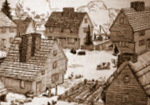from The Grafton Family of Salem
His [Joseph Grafton's] first wife was Mary, daughter of Thomas and Ann Moore of Southwold, England, whose mother was certainly living here, for
goodwife Grafton requesteth a pcell of land for hir mother at ye ende of hir husbands lott & it is granted to be laid out at ye discretion of the sureiors,
August 28th 1737.
Thomas Moore died before 1636.
It is also evident that, beside the daughter Mary, there was also in Salem a son Thomas, for
11th 5th mo. 1636 Thomas Moore soone to widow Moore & his wife are received for Inhabitants and may haue one fishing lot on the neck. (Salem Town Records.)
On August 17, 1668, Anne More of Salem, widow, executed another deed to John Turner, mariner, for a messuage [dwelling house with outbuildings and land assigned to its use] or tenement at Salem, a dwelling house, with all the ground adjoining containing one acre and three-forths, partly an orchard and part arable, lyng on the south by the highway that ran between the premises and the south harbor, and westerly with the house and land of Joseph Grafton, senior, northerly with the land of Edward Wollen, and easterly with the land and house of Nathaniel Grafton formerly bot of Ann More. The whole including that sold to N. Grafton, containing about two acres.
The deed was acknowledged on February 9, 1668 (12 mo. 9), and recorded at Salem, Lib 3 of Deeds, p. 49.
This enables the site of her house and land to be yet traced, as well as Turner's wharf at the foot of Turner street, now having another name. And it is satisfactory evidence that she, the widow, was living in 1668. By tradition her son Thomas helped her build the house, and perhaps he lived in it, while he lived in Salem.
It was a curious imitation of the manor law in England, that she had to appear in court at Salem to have the sale of her house and land allowed; stating that she sold the same "for her necessary use". . .
In the first list of grants, December 26, 1636, to July 12, 1637, is the entry, "Tho: Mores widdow 10 acres."
On the 20th of the 12th mo. 1636 these 10 acres were laid out
att Jeffrys Creek" (Manchester). The 3d of 1st mo. 1637 the "Widoo Moore desireth a howseloote (vpon) neere vnto the Winter Iland among the ffishermanns lotts.
The 20th of the 9th mo. 1639 she "desireth a ffarme."
In Roger conant's list, which probably refers to the division of "the Marsh & meadow lands" on 25th of 10th mo. 1637, she had 5 in her family and was therefore entitled to 3/4 of an acre.
finally on the 30th of the 7th mo. 1644
The Widow Moore the midwiefe . . . shall . . . haue so much of the wett marsh or swampe as lyes before (her) ground. (Salem Town Records.) . . .
There is one more reference to his wife's mother:-
Joseph Graftons mother in law forgotten in the devision shall have her halfe acrs of marsh land,
June 25th 1638.


